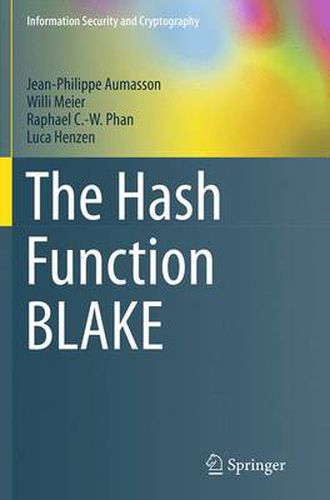Readings Newsletter
Become a Readings Member to make your shopping experience even easier.
Sign in or sign up for free!
You’re not far away from qualifying for FREE standard shipping within Australia
You’ve qualified for FREE standard shipping within Australia
The cart is loading…






This title is printed to order. This book may have been self-published. If so, we cannot guarantee the quality of the content. In the main most books will have gone through the editing process however some may not. We therefore suggest that you be aware of this before ordering this book. If in doubt check either the author or publisher’s details as we are unable to accept any returns unless they are faulty. Please contact us if you have any questions.
This is a comprehensive description of the cryptographic hash function BLAKE, one of the five final contenders in the NIST SHA3 competition, and of BLAKE2, an improved version popular among developers. It describes how BLAKE was designed and why BLAKE2 was developed, and it offers guidelines on implementing and using BLAKE, with a focus on software implementation.
In the first two chapters, the authors offer a short introduction to cryptographic hashing, the SHA3 competition and BLAKE. They review applications of cryptographic hashing, they describe some basic notions such as security definitions and state-of-the-art collision search methods and they present SHA1, SHA2 and the SHA3 finalists. In the chapters that follow, the authors give a complete description of the four instances BLAKE-256, BLAKE-512, BLAKE-224 and BLAKE-384; they describe applications of BLAKE, including simple hashing with or without a salt and HMAC and PBKDF2 constructions; they review implementation techniques, from portable C and Python to AVR assembly and vectorized code using SIMD CPU instructions; they describe BLAKE’s properties with respect to hardware design for implementation in ASICs or FPGAs; they explain BLAKE’s design rationale in detail, from NIST’s requirements to the choice of internal parameters; they summarize the known security properties of BLAKE and describe the best attacks on reduced or modified variants; and they present BLAKE2, the successor of BLAKE, starting with motivations and also covering its performance and security aspects. The book concludes with detailed test vectors, a reference portable C implementation of BLAKE, and a list of third-party software implementations of BLAKE and BLAKE2.
The book is oriented towards practice - engineering and craftsmanship - rather than theory. It is suitable for developers, engineers and security professionals engaged with BLAKE and cryptographic hashing in general and for applied cryptography researchers and students who need a consolidated reference and a detailed description of the design process, or guidelines on how to design a cryptographic algorithm.
$9.00 standard shipping within Australia
FREE standard shipping within Australia for orders over $100.00
Express & International shipping calculated at checkout
This title is printed to order. This book may have been self-published. If so, we cannot guarantee the quality of the content. In the main most books will have gone through the editing process however some may not. We therefore suggest that you be aware of this before ordering this book. If in doubt check either the author or publisher’s details as we are unable to accept any returns unless they are faulty. Please contact us if you have any questions.
This is a comprehensive description of the cryptographic hash function BLAKE, one of the five final contenders in the NIST SHA3 competition, and of BLAKE2, an improved version popular among developers. It describes how BLAKE was designed and why BLAKE2 was developed, and it offers guidelines on implementing and using BLAKE, with a focus on software implementation.
In the first two chapters, the authors offer a short introduction to cryptographic hashing, the SHA3 competition and BLAKE. They review applications of cryptographic hashing, they describe some basic notions such as security definitions and state-of-the-art collision search methods and they present SHA1, SHA2 and the SHA3 finalists. In the chapters that follow, the authors give a complete description of the four instances BLAKE-256, BLAKE-512, BLAKE-224 and BLAKE-384; they describe applications of BLAKE, including simple hashing with or without a salt and HMAC and PBKDF2 constructions; they review implementation techniques, from portable C and Python to AVR assembly and vectorized code using SIMD CPU instructions; they describe BLAKE’s properties with respect to hardware design for implementation in ASICs or FPGAs; they explain BLAKE’s design rationale in detail, from NIST’s requirements to the choice of internal parameters; they summarize the known security properties of BLAKE and describe the best attacks on reduced or modified variants; and they present BLAKE2, the successor of BLAKE, starting with motivations and also covering its performance and security aspects. The book concludes with detailed test vectors, a reference portable C implementation of BLAKE, and a list of third-party software implementations of BLAKE and BLAKE2.
The book is oriented towards practice - engineering and craftsmanship - rather than theory. It is suitable for developers, engineers and security professionals engaged with BLAKE and cryptographic hashing in general and for applied cryptography researchers and students who need a consolidated reference and a detailed description of the design process, or guidelines on how to design a cryptographic algorithm.